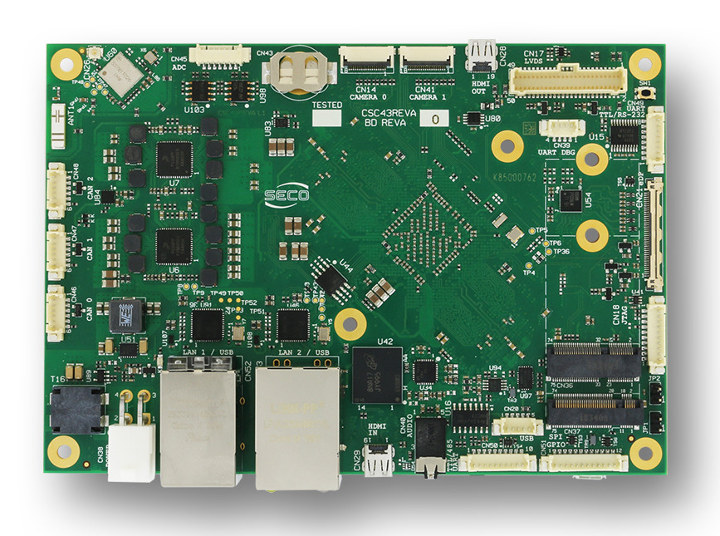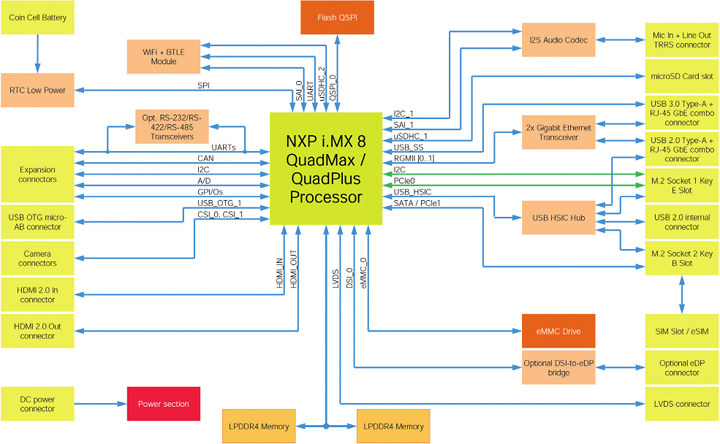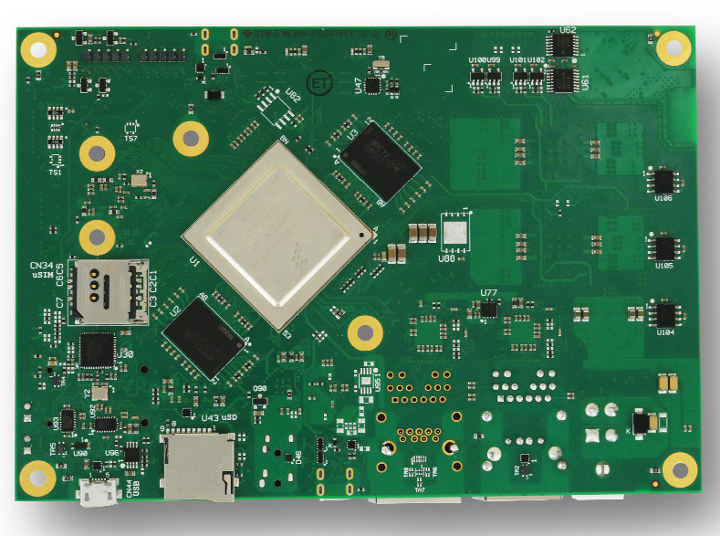When NXP unveiled their first 64-bit i.MX processors in 2016, we had three families: i.MX 8 Cortex-A72/A53 for high performance, i.MX 8M Cortex-A53 for audio/video application, and i.MX 8X Cortex-A53 for low power applications. Most of the designs we’ve seen so far are based on i.MX 8M family, and we’ve seen few hardware platforms based on the top of the line i.MX 8 QuadMax SoC with two Arm Cortex-A72 cores, four Cortex-A53 cores, two Cortex-M4F real-time cores, and two GC7000XS/VX GPUs.
We did cover several modules based on i.MX 8 QuadMax processor including Advantech ROM-7720 Qseven 2.1 Computer-on-Module, Toradex Apalis i.MX 8 CoM, and Congatec conga-SMX8 SMARC 2.0 SoM among others, but AFAICR I had yet to see an i.MX 8 QuadMax single board computer.
So Seco SBC-C43 appears to be the first SBC powered by NXP’s most powerful i.MX 8 processor, coupled with up to 8GB DDR4, 32GB eMMC flash, wired and wireless connectivity, HDMI 2.0 input and output, two M.2 sockets and more.

Seco SBC-C43 SBC is also available with other variants of i.MX 8 processor, but the rest of the specifications are the same:
- SoC (One or the other)
- NXP i.MX 8QuadMax with 2x Cortex-A72, 4x Cortex-A53, 2x Cortex-M4F, 2x Vivante GC7000/XVSX GPU, and 4K VPU
- NXP i.MX 8QuadPlus with 1x Cortex-A72, 4x Cortex-A53, 2x Cortex-M4F, 2x GC7000Lite/XVSX GPU, and 4K VPU
- NXP i.MX 8Quad with 4x Cortex-A53, 2x Cortex-M4F, 2x GC7000Lite/XVSX GPU, and 4K VPU
- System Memory – 2GB, 4GB, 6GB, or 8GB LPDDR4-1600MHz
- Storage
- Up to 32GB eMMC 5.1 flash
- 4MB Quad SPI NAND flash (boot only)
- MicroSD slot
- M.2 Key B socket for SATA drive
- Video
- Output
- HDMI 2.0a output port up to 4K
- Optional eDP 1.4 interface up to 4K
- Dual-channel 18/24-bit LVDS up to 1080p
- Four independent display support
- Input
- HDMI 2.0a input port
- 2x 4-lane MIPI-CSI for camera(s)
- Output
- Audio – I2S audio codec, Mic-in, line-out via single combo TRRS connector
- Connectivity
- Dual Gigabit Ethernet (RJ45)
- WiFi 5 802.11 a/b/g/n/ac + Bluetooth 4.2 LE module with ceramic SMT antennas
- M.2 Socket 2 Key B Slot for M.2 Modems + SIM slot
- M.2 Socket1 Key E Slot for WiFi + BT external modules
- USB – 1x USB 3.0 host port, 1x USB 2.0 host port, 1x micro USB 2.0 OTG port, 1x USB 2.0 header, 2x USB 2.0 interfaces via M.2 slots
- Expansion I/Os
- Serial – 3x UARTs (RS-485/RS-422, RS-232, TTL), 3x CAN
- 6x GPIO
- 4x analog inputs
- SPI, I2C
- M.2 Key E for PCIe/USB wireless, etc.
- M.2 Key B for SATA, PCI-e x1,
- Misc – Embedded additional RTC
- Power Supply – 12V DC input
- Dimensions – 146 x 102mm (3.5″ board)
- Temperature Range – Commercial: 0 to or 60°C; industrial: -40 to 85°C
The company provides Yocto, Wind River Linux, Android support for the board. Target applications include biomedical and medical devices, digital signage and infotainment, edge computing, industrial automation, IoT, smart vision, and vending machines.
Seco SBC-C43 is still shown as being under development in the product page, and as a result availability and pricing information is still now available.

Via LinuxGizmos

Jean-Luc started CNX Software in 2010 as a part-time endeavor, before quitting his job as a software engineering manager, and starting to write daily news, and reviews full time later in 2011.
Support CNX Software! Donate via cryptocurrencies, become a Patron on Patreon, or purchase goods on Amazon or Aliexpress






The last SBC with a NXP SoC embedded that i worked was a Udoo. I remember that it was really slow and the support was bad.
It is just a Udoo thing or a thing with SBC with NXP SoCs?
Udoo is a sub company of SECO.
The main problem with UDOO was the lack of support for new ubuntu distribution because they did not invest in developers to port new kernels and device tree from NXP resources. Also, exist the possibility to use the OS provided by NXP but you need to configure carefully the device tree and other stuffs related to the hardware of UDOO and that is time comsuming. On another hand, the support for NXP boards should be very good since they always are updating everithing.
The kernel was from FSL, (Freescale/NXP) , with patches from developers. Wonder, if the IMx8 is any better, i.e. mainline? Also, the M4 was not that easy to debug using JTAG.
I’m wondering why we don’t see Armada 8040 SBCs beyond those made by SolidRun. This SoC has lots of CPU power (4xA72@2GHz) and tons of I/O. For a board like the one above it could make quite some sense if more CPU is needed.
I think it’s Armada’s lack of GPU that hampers former’s presence on markets that require media-capable SoCs.
sub 10usd minipcie gpus could be interesting, if anyone managed to pull it off? especially if they had open drivers
I don’t think such a thing exists. The cheapest mPCIe VGAs (dumb fb) using Silicon Motion’s SM750 go for an order of magnitude more than what you’re referring to — the’re just too niche a product to reach such low price ranges. The other way around — adding a 4x PCIe slot to the board like on rockpro64 — appears to be the more viable approach. Apropos, all A8040 boards that solid-run currently produce have a 4x PCIe slot. They just don’t come in small form factors (or cheap).
There is QNAP TS-1635AX-4G-US 12+4 Bay but they cost $1,270
I think he asked about Armada 8040 SBCs
You are right I am being cheeky, as its inside a whole device 😉
For me the fun was over when I read m.2 b single lane…
Well, https://github.com/ThomasKaiser/Knowledge/blob/master/articles/PCIe_and_ARMv8_SoCs.md
The one PCIe lane that is multiplexed with SATA is routed to the M.2 key B slot for obvious reasons, while the key E slot most probably is x2. At least it’s Gen3 here…